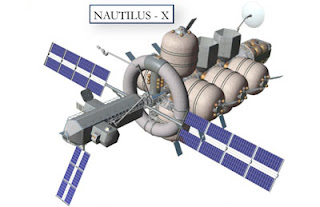Smacking Asteroids For Resources
Summer studies of space settlements by Gerard O'Neill and NASA in the 70s and again in the early 90s both determined that significant amounts of mass is required for passive radiation shielding. Although structurally, most designs call for refined steel, it has been suggested that mass for the shielding could just be raw lunar regolith, left-over slag from future on-orbit industrial processing, or obtained from the asteroids. The asteroids are seen as preferable as, in terms of delta-v, they are most easily available. The typical argument is that a long duration mission to rendezvous with a near-Earth asteroid or comet (collectively, near earth objects, or NEOs) could skip a lot of launches from deep gravity wells, either digging into the NEO or
dismantling and processing it to make a nearby structure, or both.
The wrinkle, however, is in that "long duration" part. In terms of delta-v, there are NEOs which are easier to hit than the Moon, but all currently known NEOs require months to year long travel times. This rules out manned expeditions for the time being, as long duration human spaceflight beyond the Van Allen radiation belt requires significantly more shielding than Apollo style short term missions.
To break the stalemate, many have suggested the use of autonomous or teleoperated spacecraft to develop a soon-to-be Earth Hill-sphere crossing NEO into a life sustaining capable radiation bunker. As many appropriately sized NEOs cross within 2 or 3 lunar distances (LD) of the Earth, it's clear that only a short term mission is required to "jump on board" and bunker down. With adequate prediction of the NEOs orbit, resupply could be successfully staged ahead of time on slower, more energy efficient, trajectories.
When considering the risk involved in such an adventure, and the market opportunities of any such settlement, Earth or Moon orbiting alternatives start to sound a lot more attractive. So let's consider an orbital habitat that is closer to home.
To get mass from the surface of the Moon into an appropriate orbit, it is suggested, one can use a solar powered mass driver. The immense cost of building a lunar mass driver is quickly amortized over every kg of steel and regolith launched and the sheer quantities of mass required - 150,000 kg for the torus designs, 42,300,000 kg for the cylindrical designs, and that's just the structural mass (steel), for shielding it's 9.9 and 23.3 million tons of regolith - mass drivers beat rockets hands down. But building a mass driver of that scale, and all the infrastructure required to supply it with regolith and power is another roadblock. When people talk about it, I suggest that by the time those quantities of regolith are available from lunar industry there will be tract housing available there anyway.
Do we have to rule out NEOs for shielding of Earth or Moon orbiting space settlements?
Recently, the asteroid 2010 AL30 flew by Earth, closer than the Moon's orbit, traveling at a relative velocity of 9855 m/s. Approximately 10-15 meters in size, it is estimated to be one of nearly 2 million such objects in near-Earth space. On average, an asteroid of this size passes within a lunar distance once a week. Asteroids come in a variety of different types and densities, but on the lower end of the spectrum (2.6g/cm^3), 2010 AL30 would have a mass of at least 2,600,000 kg.
Capturing small asteroids like this in Earth or, better yet, the Moon's gravity is a difficult proposition. For the altitude that 2010 AL30 was traveling at, it would have to lose 8139 m/s of velocity to enter a circular orbit. Suppose we were to send a spacecraft to hit it head-on. The most recent example of an impactor in near-Earth space was the LCROSS mission, impacting a crater at the lunar south pole, it delivered a 2305 kg Centaur stage at 2700 m/s. If we take that velocity as representative, we would require our spacecraft to have a mass of 7,929,037 kg.. unsurprisingly, we require a bigger rock to slow down the smaller rock.
A better question might be, how big of an asteroid can we capture by head-on impact with a Centaur stage? Again using 2700 m/s as a reference, you'll find the asteroid can be no more than 756 kg in mass, which converts to an asteroid 66 cm on a side using the same density as before.
LCROSS was launched as a secondary payload on an Atlas V 401. The Centaur provided the entire burn, although there was a small amount of gravity assist provided by the Moon. The shepherding spacecraft followed the Centaur into Cabeus crater as the Moon is quite a hard target to miss at that range, but I can imagine a similar spacecraft avoiding the brunt of the impact of intercepting an asteroid. If the
spacecraft is equipped with a solar powered propulsion system, be it Hall-effect thruster or an electrostatic ion thruster (as used on the Deep Space 1 spacecraft that did a flyby of a comet) or even a mass driver, it is conceivable it could rendezvous with the various fragments, assemble them into a whole and shepherd them to another intercept.
As the shepherded mass grows, larger asteroids can be intercepted.
Such a spacecraft could also find purpose cleaning up more traditional
orbital debris.
Note: I wrote this a while ago, but forgot to post it, I'm not terribly sure of the math anymore. It seems about right, but I know now there are lower delta-v asteroids that wiz by the Earth within a lunar distance. But it has some good references.



Comments
Post a Comment